There are fifteen (15) good companion plants for coral bells in this list ranging from daisies to hostas, to irises. Explained below are some reasons why planting other complimenting plants near them is good for their health and development.
Table of Contents
Introduction to Heuchera and Companion Planting
Heuchera is a genus of flowering plants in the Saxifragaceae family. The species in this genus are largely perennial and evergreen plants and they are all native to (originally found in and adapted to) North America.
Plants of the genus Heuchera are known as alumroot or coral bells. They have whole, palm-shaped leaves, with the leaflets stemming from the leaf base, and long leaf stalks. There are approximately 37 species within the genus Heuchera.
These species grow in several habitats so they look different and have varied growing needs. Although they also have medicinal uses, they are mostly grown as ornamental plants, with many hybrids and varieties. The most common species of coral bells have deep to vivid reddish pink flowers.
Their flowers are small and filled with nectar. They make a lot of pollinators, including birds and butterflies, interested in the garden space and so these flowers aid the process of pollination in themselves and other flowering plants around them (called angiosperms).
Leaves in plants of the genus Heuchera may be gold, green, purple, red or rose-colored. Their leaves are also colorful and very beautiful or aesthetically pleasing. These versatile plants thrive in shaded areas, making them perfect for a shade garden, where they receive indirect light and can enjoy the coolness provided by deciduous trees.
You can maximize the space in your garden by planting coral bells in areas where other crops may not be able to thrive due to sunlight needs. Because of the shade tolerant nature of these plants, they may be planted underneath taller crops and indoors.
Although they do not need to be fully exposed to the sun, especially during midday, coral bells may appreciate being planted in a sunny area in colder regions. They require well drained, moist and rich soil for the best results.
Their soil must also be neutral to acidic, with pH of between 6.0 and 7.0. These are general rules and guidelines if you want to plant common species of coral bells in your garden, as several species with varying needs exist.
Coral bells are prone to diseases and the infestation of several crop pests. They may be attacked by mildew, mold, rust, voles and weevils (black vine and strawberry root weevils). They are not bothered by slugs or snails.
Several other crops may be planted alongside plants in the genus Heuchera in your garden to encourage their growth, provide shade, replenish soil nutrients and be compatible. They are usually plants with similar growing conditions and those with complimentary flowers.
Such grouping for the purpose of sharing benefits is called companion planting. It is a tried and true method, ensuring for years that crops are grown with some other crops that help them grow healthy.
Good Companion Plants for Heuchera
In the quest for a beautiful plant combination, the colorful foliage of coral bells makes them excellent mixed bedding plants. They’re not only easy-care plants but also bring a burst of bright color to the garden design, especially in shady locations. When considering companion plants, look for those that share Heuchera’s love for well-drained soil, consistent moisture, and partial sun.
1. Anemones

Windflowers are the flowering plants in the genus Anemone which belongs to the buttercup family Ranunculaceae. These perennial plants are originally found in the temperate and/or subtropical parts of almost all continents. They however are not found in Australia and Antarctica.
Different species in the genus Anemone can be grown near your coral bells. This is because the herbaceous perennials usually have vibrant pink, purple, red or white flowers that add hue and beauty to your garden space.
Because they are taller than coral bells, you can plant these windflowers behind your Heuchera. In all, plants in the genus Anemone serve as very good companions for your coral bells in the garden. Another reason for this is that plants between both genera grow in similar conditions.
Anemones flourish in well-drained soil, thriving in light conditions similar to those preferred by Heuchera, making them perfect companions in a garden that enjoys the dappled shade under a deciduous tree. Any soil type that has proper drainage and is rich enough to foster their growth is very suitable for these plants. Some species may however grow in slightly damp soil.
They can be planted indoors in partial shade or outdoors in full sun or shade. Anemones are tolerant of shade but thrive also underneath sunlight for six to eight hours daily. Plant your Heuchera in their shade or you can grow both plants in an area with shade and low sunlight.
You can identify anemones in bloom by their lovely flowers. The flowers are produced singly and their sepals are shaped like small leaves. Their leaves have long stalks and may stand upright, or not.
The leaves of anemones are simple and have varying kinds of leaf blades. They produce egg-shaped fruits also. Because of convenience, similar growth needs and beautification, it is advisable to plant crops within the genus Anemone with or near others in the genus Heuchera.
2. Astilbes

Astilbe is a genus of about eighteen (18) species of plants known as false goat’s beard or false spirea. They are flowering plants that belong to the family Saxifragaceae. Their flowers, which resemble feathers, are usually a shade of red, pink or purple.
Plants within this genus are native to forests and ravines in Asia and North America. They are fairly hardy and thrive in partial shade like coral bells but they can also grow in full sun in cooler weather or climates.
The soil requirements of these two kinds of plants are also similar. Plants in the genus Astilbe produce the best results in terms of yield when they are grown in moist loamy soil and shaded areas.
False goat’s beards serve as very good companion plants for Heuchera in the garden. In addition to thriving in similar conditions to those that your coral bells grow very well in, these plants have beautiful leaves and flowers that are very complementary although contrasting.
You can choose the shorter or mid length varieties of astilbes for companion planting with Heuchera. Both plant genera may need similar care and most likely would, especially since their growing conditions are also quite similar.
Depending on what you need it for and what variety it is, a plant in the genus Astilbe can be planted at different spots for different purposes. It may be used as ground cover, grown in a plant pot, or, if it is a taller variety, used to shade your coral bells a bit.
These plants grow very well beside coral bells as both have similar needs, their leaves and flowers are complimentary, and Astilbe may be used for several purposes near Heuchera plants.
3. Azaleas
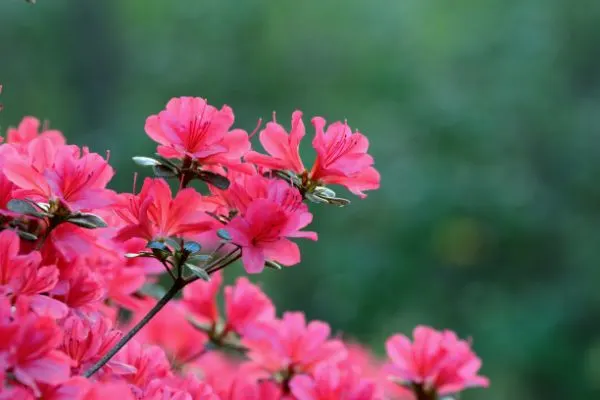
Azaleas are small- to medium-sized perennial flowering plants within the genus Rhododendron, which belongs to the heath or heather family Ericaceae. They have been bred for hundreds of years and thousands of cultivars also exist in azaleas.
These plants are native to Asia, Europe and North America, where they are cultivated largely for ornamental purposes. Azaleas produce very beautiful flowers which may be pink, red or any related shade of color.
They grow slowly, preferring to be cultivated in soil that is well draining, acidic and fertile (although they do not need too much fertilizer). They, much like coral bells, love to grow in the shade: beneath trees and away from direct sunlight.
Azaleas, with their preference for acidic soil and afternoon shade, serve as great companion plants for Heuchera, especially in warm climates where consistent moisture is key. They thrive around each other, as their needs are not different and demanding. Both plants are tolerant of the shade and love to be cultivated in moist, well drained soil.
It is advisable and pleasant to grow coral bells alongside other plants that have similar growth needs and beautiful flowers or foliage. This is because they add to the aesthetics of your garden without needing to make your coral bells uncomfortable because of any substantial differences.
As a result, it can be very good to plant azaleas nearby in your garden bed. Their pretty blooms usually blossom in the time between winter and summer, and depending on the plant variety, the leaves may shed annually or be evergreen.
There are many types and varieties to choose from in the azalea species. You can pick the one best suited for your coral bells and garden in general based on flower color, leaf size and even flower size.
4. Daylilies
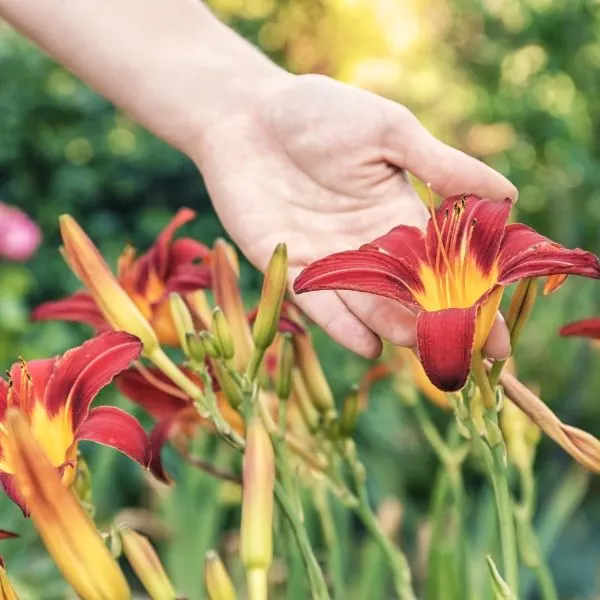
Daylilies or day lilies are flowering plants in the genus Hemerocallis within the family Asphodelaceae. They are perennial plants cultivated widely because their flowers are very attractive. These flowers typically last about only a day, which is the reason for the plant’s common name.
Growing perennial crops like daylilies near coral bells is a good move as daylilies are aesthetically pleasing beside and thus good companion plants for Heuchera. Daylilies grow to about between 2 and 4 feet in length.
They are also comfortable in close proximity to your coral bells because both plants can thrive in similar conditions. Coral bells prefer shaded areas where they do not encounter the afternoon sun but can receive 4 to 6 hours of direct sunlight per day.
On the other hand, daylilies thrive in areas where they can receive full sun for 6 to 8 hours daily. They can however grow well in partial shade but they produce less flowers. So, if you plan to plant them together, choose a spot where they can receive direct sunlight for about 6 hours daily.
Daylilies also need well drained fertile soil, preferably loamy soil, to grow well. They are even drought and heat tolerant, able to thrive in a wide range of areas and easy to cultivate because they have low care needs (most daylilies are low maintenance plants).
The beautiful and showy flowers of daylilies may come in several colors such as soft coral, yellow, pink, red and vivid orange. The plants are also in different sizes, so pick the species and varieties best suited to your garden plan.
5. Ferns
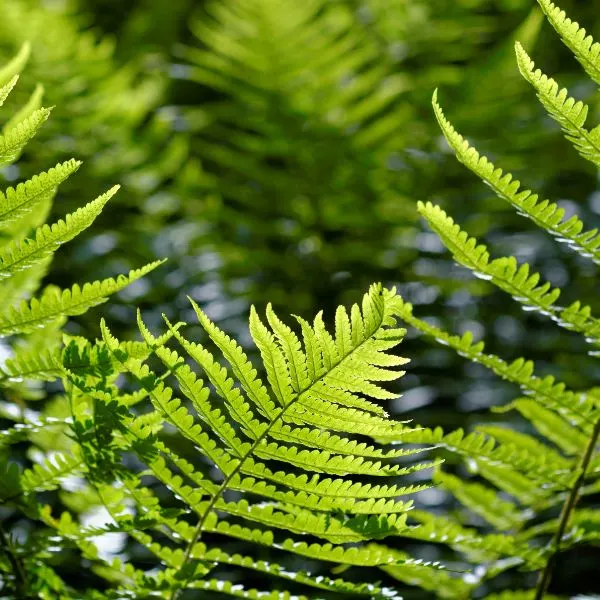
Ferns are non-flowering plants known collectively as vascular plants. They reproduce via units known as spores, as they have neither seeds nor flowers for their reproduction. They also have structures known as xylem and phloem.
There are several kinds of ferns, usually producing furled or curled fronds known as fiddleheads, which are used for food as vegetables. These ferns have a special type of leaf called microphyll which has a single and unbranched leaf vein.
Although they are not as economically important as other plants that produce seeds, ferns are used as food (including their fiddleheads), for medicine, as beautification or ornamental plants, as fertilizer and for many other purposes.
Like your coral bells, they tend to grow well in shaded areas where they receive indirect light. You can maximize the space in your garden by planting ferns with coral bells in areas where other crops may not be able to thrive due to sunlight needs.
These vascular plants do not need to be fully exposed to the sun, especially during midday. Because of their origin, ferns also require high humidity in their growing areas and moist soil. Only a few kinds can withstand direct sunlight and low humidity.
Generally, ferns tend to be very good companion plants for Heuchera. They do not produce flowers so they just have green foliage. The presence of coral bells and their lovely flowers is good for adding color and vibrancy to your garden space.
You can choose out of the many fern varieties to plant near your Heuchera, and we will cover one very ideal kind of fern later in the article. Ferns and coral bells love the same growing environment, and Heuchera can protect your ferns from many harmful pests with their bitter foliage.
6. Geraniums

Geraniums or cranesbills are any of about 422 species of annual, biennial or perennial flowering plants that belong to the family Geraniaceae. They have beautiful flowers in a range of colors including blue, pink, purple and white.
Their moisture needs are not cumbersome. They require constant amounts of water in their earlier days and become drought resistant later on. They grow comfortably as long as the soil is not soggy or waterlogged.
Geraniums prefer to be watered when their soil has dried a little but the roots are not completely dried out. They are not very hardy or cold tolerant and should be planted around times of the year when there is no longer a danger or risk of frost.
Caring for these plants is straightforward, requiring good drainage and a spot that receives afternoon shade, aligning perfectly with Heuchera’s needs for a vibrant foliage display throughout the growing season. They simply do not need too little amounts of sunlight or too much fertilizer. They like to be grown in sunny spots where they can receive 4 to 6 hours of sunlight daily.
Most species of geraniums, save one, prefer to grow under direct sunlight so to corroborate your coral bells’ needs, you can find a spot where both plants receive direct sunlight for about 6 hours daily, but away from the afternoon sun.
You may use mulch to retain some moisture within the soil. When they blossom, geraniums may attract bees, butterflies and hummingbirds with their flowers. These pollinators aid the reproductive process of pollination in other plants.
Geraniums also repel some destructive insects like cabbage loopers, corn earworms, Japanese beetles, leafhoppers and wasps. By so doing, they make for a healthy ecosystem in your garden while also enhancing its beauty and attracting several useful insects to the area.
7. Hellebores
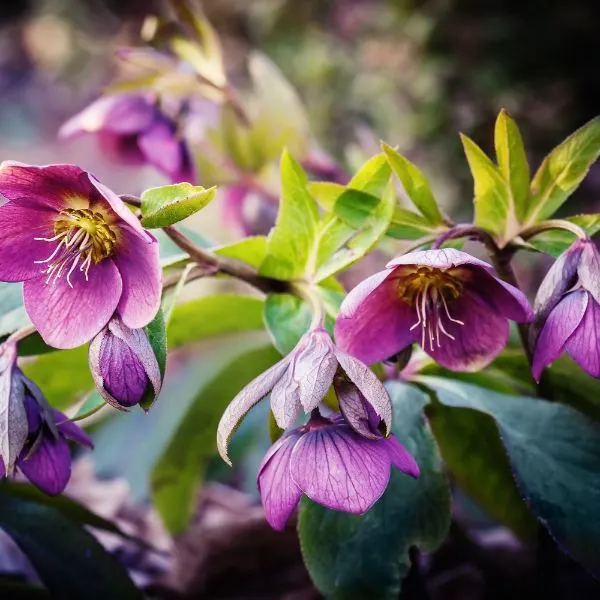
The flowering plants commonly known as hellebores are the members of Helleborus, a genus of approximately 20 species within the family Ranunculaceae native to Europe and Asia. They are herbaceous or evergreen perennials and many of them are poisonous.
Although not closely related to the rose family Rosaceae, the members of this genus are also commonly called Christmas roses, Lenten roses or winter roses instead of hellebores. They are good companion plants for Heuchera.
Hellebores usually have flowers of different shapes and colors, but all are beautiful, with small cup-shaped nectaries which in essence are petals that have been modified to hold nectar. These flowers also have five sepals that resemble petals but do not fall as petals would.
You can comfortably plant hellebores with your coral bells, as both plants fare well in similar environments and their needs are alike. Hellebores also appreciate fertile or rich soil that is able to hold moisture well but also drain properly.
Like your Heuchera plants, they can grow as shrubs in the shade of other crops nearby, or they can be grown in plant pots. As for their sunlight needs, they thrive whether they are planted in full sun or partial shade, so choose the most suitable or appropriate location for this pairing.
They have large, often leathery leaves and their bowl-shaped flowers which bloom from late winter to early spring come in a number of colors, including apricot, dusky pink, green, maroon, metallic blue, slate, white and yellow.
Hellebores and coral bells may be planted together in a shaded portion of your garden. They looked great when paired up because of their beautiful flowers, and they have corresponding soil and care needs.
8. Hostas
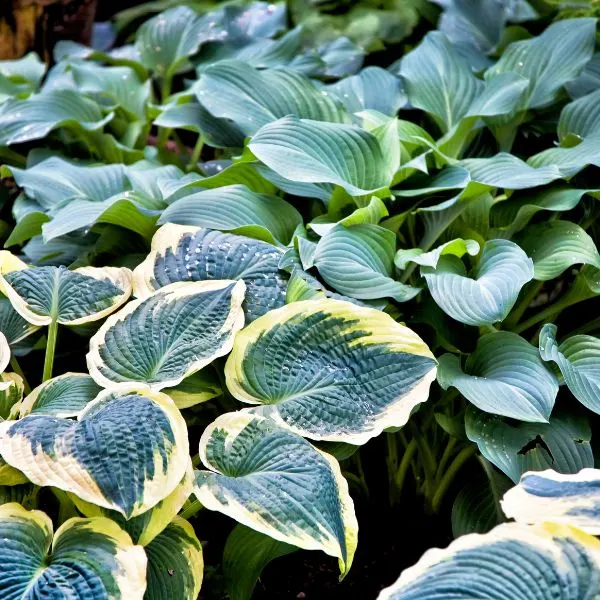
Hostas, also known as plantain lilies, are the monocotyledons in the genus Hosta which belongs to the biological family Asparagaceae. The plants in this genus were once classified under the lily family Liliaceae.
They are flowering plants, tolerant of shade and native to the northeastern part of Asia. Hostas have large, showy leaves that look very beautiful beside those of your coral bells. The color of these leaves may be any shade of green, blue or yellow.
Hostas also produce stunning blue, purple or white flowers when they are in bloom and these complement your coral bells’ flowers. In all, hostas are a lovely addition to your garden beside Heuchera plants because they improve the aesthetic of the area.
Also, because they are tolerant of shade and love moisture, hostas and coral bells grow very comfortably around each other. Several sizes, shapes, colors and species of hostas exist and they may be planted in various ways near your coral bells.
The plants in the genus Hosta tend to be among the best companion plants that plants in the genus Heuchera could have as neighbors. Their large leaves are very beautiful, and so are the other parts of their short shoots.
They are mostly shrubs, as they usually do not grow very tall. They may be planted indoors as ornamental plants as well. Like coral bells, they prefer to be grown in partial shade and are fairly easy to maintain.
Hostas need to be grown in rich, well drained soil as they do not do well in waterlogged soil. There are a lot of varieties to choose from, with blossoms of different colors that appear in the summer. Species that best suit your garden plans should be considered and planted alongside your coral bells.
9. Impatiens
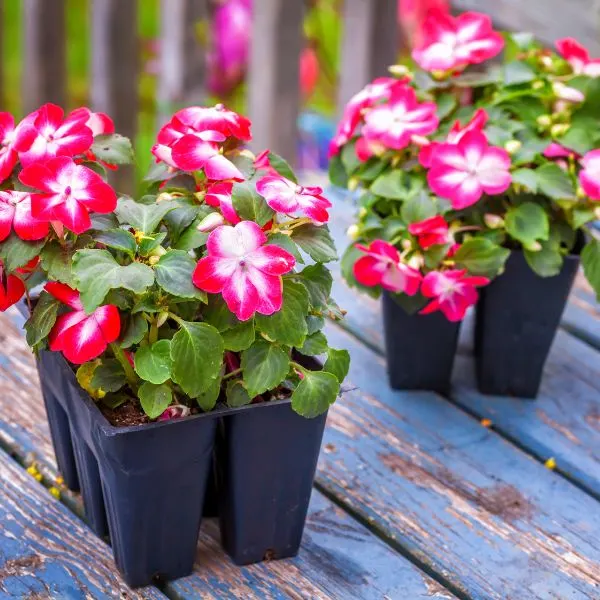
More commonly called busy lizzies, jewelweeds, patience, snapweeds or touch-me-nots, Impatiens is a genus that comprises more than a thousand species of flowering plants. The genera Impatiens and Hydrocera make up the family Balsaminaceae, which is known as the balsam family.
Touch-me-nots are mostly and widely found in the Northern Hemisphere and other tropical parts of the world. They vary in size, as some plants may be as short as 5 cm (0.05 m or 1.97 in) or as tall as 250 cm (2.5 m or 98.4 in).
Most of the species are annual plants or perennial ones with succulent stems, as only a small number of them are woody species. There are various sizes of leaves, flowers and other plant parts, and they differ by species.
Generally, plants in the genus Impatiens are good companion plants for Heuchera. Like coral bells, they can thrive in the shade, often preferring to be grown under full or partial shade where they can receive sunlight for 4 to 6 hours daily as opposed to full sun for 6 to 8 hours daily.
They also appreciate rich, moist and well drained soils. Their flowers, which bloom all through the summer, come in many different colors, again depending on the species. They may be pink, purple, red, violet, white or yellow in color.
Touch-me-nots can add more color to your garden area; this can bring about the increased presence of insects and other animals that can aid pollination in flowering plants present in your garden.
Grow touch-me-nots alongside coral bells in your garden, as there are many benefits. Both plants grow very well in similar conditions. In addition to their comfort, their combination makes your garden space more aesthetically pleasing and draws pollinators to the area.
10. Irises
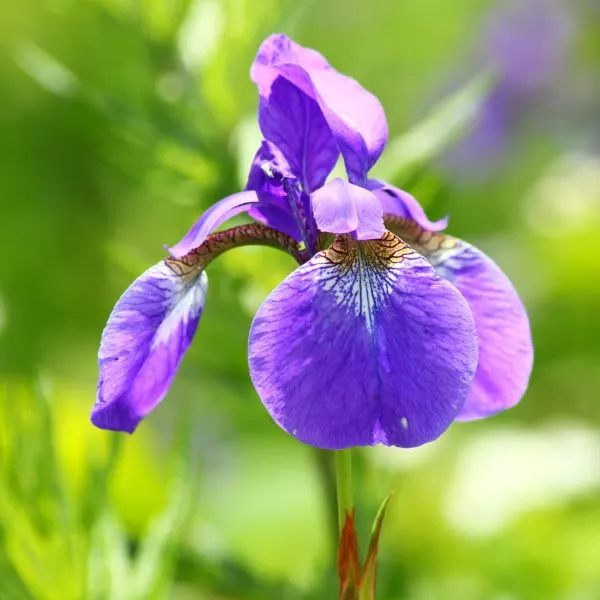
There are about three hundred and ten (310) plant species in the genus Iris. Commonly called flags or irises, they belong to the large biological family [containing about sixty-six (66) genera] Iridaceae.
Irises are flowering perennial plants commonly grown as garden flowers. Some species, known as rhizomatous irises, grow from creeping rhizomes, while others known as bulbous irises, usually in drier climates, grow from bulbs.
Iris plants differ in appearance but they generally have long, erect flowering stems. These stems may be simple or branched, solid or hollow, flattened or circular. Their leaves also have different appearances, depending on whether they are rhizomatous or bulbous species.
Rhizomatous irises can have between 3 and 10 leaves that are produced in the shape of swords and grow thickly in clumps or clusters at their base. On the other hand, bulbous irises tend to have 2 to 10 narrow leaves that grow out from their bulbs.
The fan-shaped flowers that they produce in the spring and summer are usually called “falls” because their three sepals typically droop down or spread. These beautiful flowers, full of nectar, may sometimes be black, blue, brown, orange, pink, purple, white or yellow in color.
Irises are very good companion plants for Heuchera. They thrive in rich, well drained soil and are low maintenance plants. They however prefer to be grown in a sunny area where there is no shade and they can receive 6 to 8 hours of sunlight per day.
Companionship between these two plant types is very ideal because in addition to comfort and compatibility, irises add beauty to your garden. Their gorgeous flowers look very lovely beside coral bells.
11. Japanese Painted Ferns

The Japanese painted fern is a variety or species of ferns and it serves as a good companion plant for coral bells. It is native to the eastern parts of Asia. As stated before, it is a non-flowering plant with large leaves called fronds.
Its fronds vary in length, usually between 30 to 75 cm (11.8 to 29.5 in) but some individuals have fronds that are over 100 cm (1m or 39.4 in) long. They are arranged in a tuft-shaped or feather-like manner. This is a deciduous plant with a creeping rhizome.
Japanese painted ferns are commonly grown and they can be identified by their grayish green fronds with reddish mid veins. They thrive under partial to full shade and many varieties and cultivars of this plant are known currently.
They are very ideal companion plants for your coral bells first for the fact that they can be grown together effortlessly. Their sunlight needs are nearly identical and so there are a number of conditions or areas that would suit both plants equally well.
Well draining soils that can also hold moisture properly are ideal for both Japanese painted ferns and coral bells. These ferns are easy to grow and maintain. They also improve the ecosystem of the garden by adding a different hue and vibrancy to the garden that can attract pollinators.
Generally, ferns are low maintenance, shade loving plants that thrive when grown with coral bells. Although they are not flowering plants, they have beautiful foliage that adds color to your garden, making the space impressive.
12. Lady’s Mantles
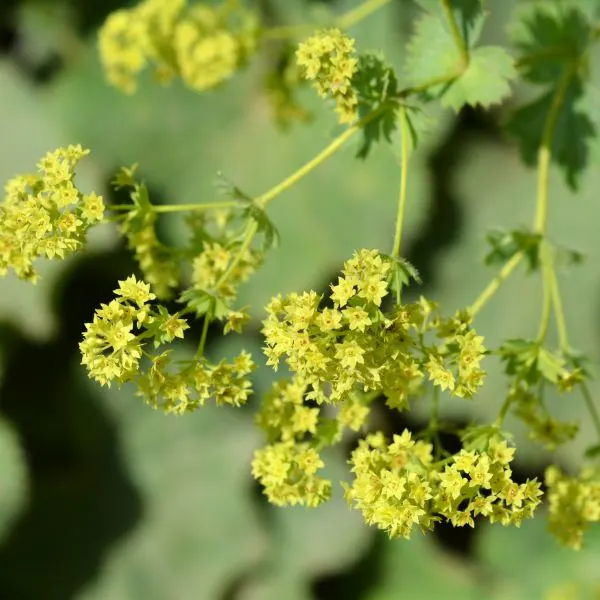
Lady’s mantle is the common name for plants that belong to the genus Alchemilla, a genus of flowering and herbaceous perennial plants within the rose family Rosaceae. Some parts of these plants may be made into a herbal tea or used for medicinal purposes.
Within this genus, there are about 700 species of lady’s mantles. Most are native to the temperate and subarctic regions in the continents of Europe and Asia, and a few are native to Africa, South America and North America.
Lady’s mantles thrive in various soil conditions. However, the plants prefer to grow in slightly acidic to neutral soil. Plants in the genus Heuchera also prefer to grow in soil with the exact same conditions. The soil must also be rich, moist and well drained.
Also, lady’s mantles are drought tolerant when established within the soil. However, they will need to be watered more frequently in areas where they are exposed to full sunlight or where there is a lot of heat so as to ensure that their leaves do not brown.
They thrive in both full sun and partial shade. They even tolerate near-complete shade so they can grow in shaded parts of your garden alongside your coral bells. They are tall, so make sure to plan carefully and know where best to grow them in your garden.
These herbaceous perennials have mid green or bluish leaves that contrast species of Heuchera with darker leaves. They also have green or yellow flowers, complementing the gold, green, purple, red or rose colored flowers of Heuchera plants.
In essence, planting coral bells and lady’s mantles next to each other in the garden bed is a good practice as it is favorable to both plants, caring for their needs, and the plants’ foliages and inflorescences are complementary.
13. Penstemon
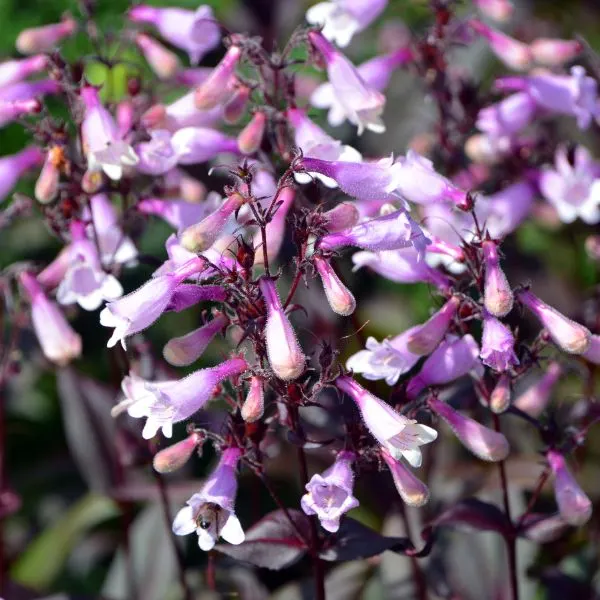
Penstemon is a genus in the plantain family Plantaginaceae. It is a large one that comprises about two hundred and eighty (280) species of flowering plants known more commonly as beardtongues or penstemons.
Most penstemons are native to the Nearctic realm (the realm consisting of subtropical, tropical, temperate and arctic parts of North America). Penstemon is also the largest genus of flowering plants endemic to the continent of North America.
They can be identified by their conspicuous staminodes (infertile stamens or male reproductive part of the plant) that differ in appearance by species. In most species, it is a long and straight stalk extending to the plant’s petals.
However, some species have longer, very hairy staminodes that generally resemble an open mouth with a hairy or frizzy tongue jutting out of it. This appearance is responsible for the more common name, beardtongue, of these plants.
Penstemons produce brightly colored flowers, usually pink, purple, red or lavender in color. They bloom in early summer and if deadheading (the removal of fading or dead flowers) is done frequently, they can keep blooming even until the fall.
They are good companion plants for species of Heuchera that prefer to grow in full sun than in shade. This is because penstemons appreciate direct exposure to sunlight for 6 to 8 hours daily. Several species of coral bells are shade tolerant so carefully pick the variety you want around penstemons.
Because the elegant flowers of beardtongues add color and attract pollinators to your garden, consider planting them with your coral bells. They also appreciate moisture retentive but properly drained soil and full sun, so there are many species of Heuchera that would go well with penstemons.
14. Pulmonaria
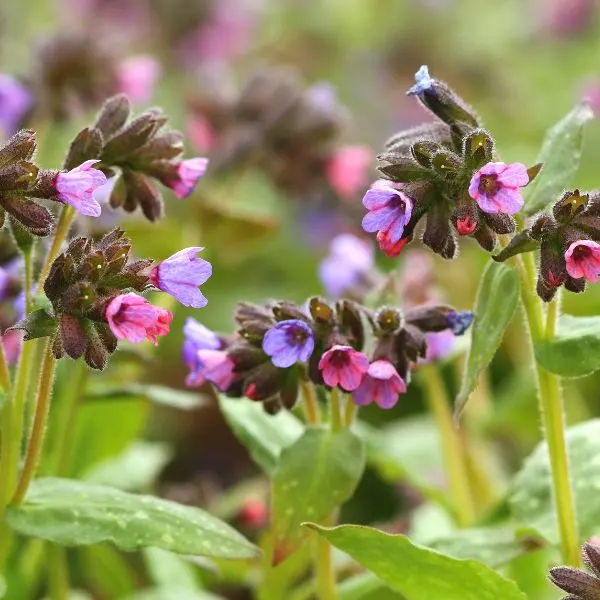
Known more commonly as lungworts, Pulmonaria is a genus of flowering plants within the borage family Boraginaceae. These perennials are mostly native to Europe and Western Asia but a single species is indigenous in eastern to central Asia.
The plants in the genus Pulmonaria are typically evergreen or herbaceous ones that grow in clusters, sometimes called rosettes. Underneath their rough and hairy straight or slightly spreading stems are creeping rhizomes (roots below the surface that serve as reproductive structures).
Lungworts are usually about 15 to 25 cm (6 to 10 in) tall and they typically do not grow past 30 cm (12 in). Their leaves, which grow in clusters as stated above, are most likely large. They come in different shapes and with distinct patterns.
Leaf shapes may range from lanceolate (narrow and tapering to a pointed tip) to oval, with their tip sharply pointed or blunt. The leaves are very hairy and the hairs on them may be prickly or soft. They may also have black, blue or pale green spots, or no spots at all.
Each species in the genus Pulmonaria has two distinct flower forms. These flowers are generally funnel-shaped and may come in the colors blue, pink, purple, red, violet or white. Lungworts are good companion plants for Heuchera.
With so many similarities, these genera are very compatible and can be grown together. Both are low maintenance plants. Lungworts appreciate partial to total shade and moist, well drained soil so grow compatible species near them. As shrubs, both genera do not grow very tall.
Coral bells can also be complemented by these companions. The flowers and leaves of lungworts add more color to your garden and do not exactly contrast but match the blossoms and foliage of your Heuchera.
15. Salvia
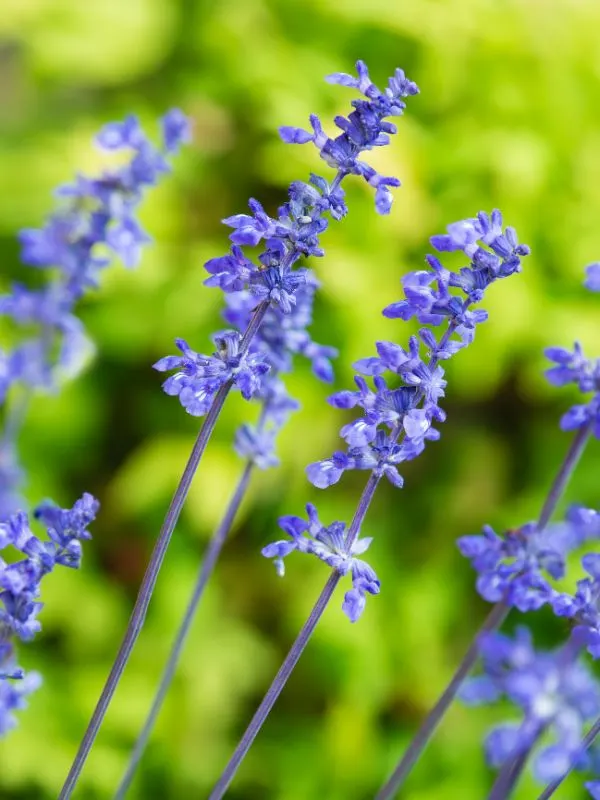
This is the largest genus of plants in Lamiaceae, the mint family, comprising about a thousand (1,000) distinct plant species. They may be shrubs, perennial herbs or annual plants and are generally referred to as sages.
The genus Salvia contains two very popular herbs: common sage and rosemary. Its species are indigenous in the Old World (Afro-Eurasia) Ava North and South America. There are about 600 species in Central and South America, 250 in Central Asia and the Mediterranean and 90 in Eastern Asia.
Several species in this genus have showy or flamboyant plant parts so they may be used for ornamental purposes. Flowers come in many colors, usually blue, pink, purple and red. White and yellow ones exist, though fewer.
Most sages feature hairs on their leaves, stems and flowers to reduce water loss in certain species but some may release or secrete oils. These oils usually lend the plant its smell and can be released by contact with the plant’s hairs (rubbing or brushing them).
For this reason, some insects and animals may stay away from them. Plants in the genus Salvia tend to be good companions for Heuchera as they are able to ward pests off with the scent of their oils.
They do this while attracting pollinators like butterflies and bees to your garden with their stunning inflorescences. Also, like many coral bells, sages like to grow in partial shade to full sun and well drained soils. Most are drought tolerant.
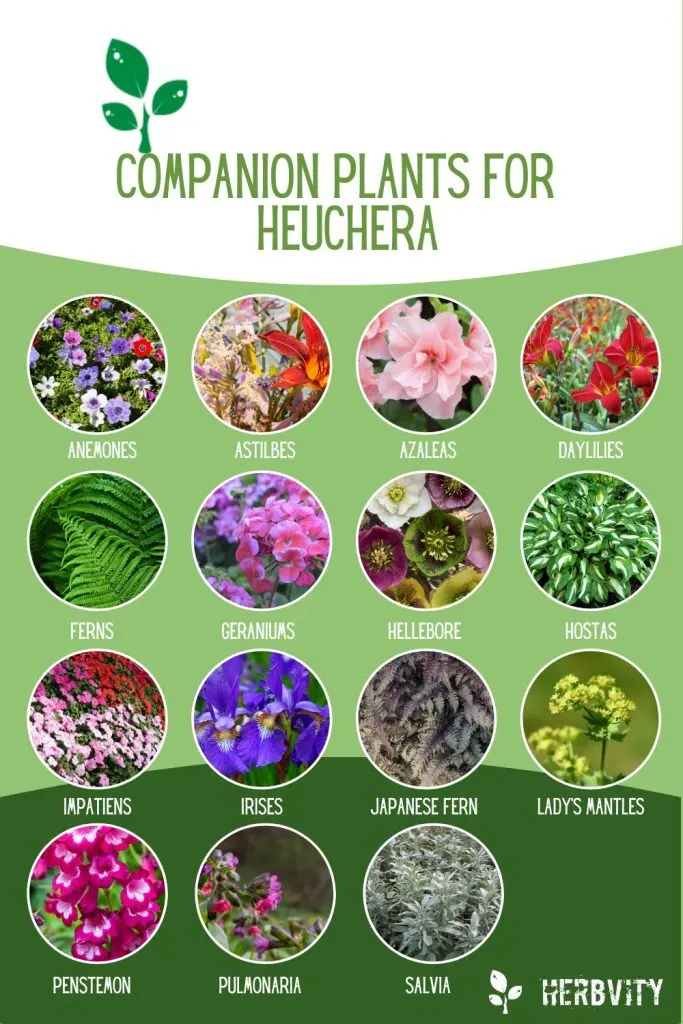
FAQs
What can be planted next to Heuchera?
Generally, other plants with beautiful foliage or blooms that have corresponding soil and care needs and will not compete for space can be planted next to Heuchera in the garden.
What plants pair well with coral bells?
Some plants that pair well with coral bells are: azaleas, day lilies, false goat’s beards (Astilbe), ferns, geraniums, hellebores, hostas, irises, lady’s mantles, lungworts (Pulmonaria), penstemons, sages (Salvia), touch-me-nots (Impatiens) and windflowers (Anemone).
Conclusion
Selecting the right companion plants for Heuchera, such as those thriving in acidic soil and shade-loving conditions, ensures a garden that remains vibrant from late spring through the summer months to late fall. Incorporating native plants and those suited for the same USDA hardiness zones will result in a harmonious and sustainable garden design, full of life and color through various seasons.
While growing coral bells, remember that their needs depend mostly on their variety. Some prefer to grow in shaded areas of the garden while others prefer growing in full sun. It is imperative to know what variety you are planting and its specific needs.
This helps you know the best spot to grow them in and what plants to cultivate beside them. For their soil, they generally need well drained and consistently moist soil types with neutral to acidic pH of 6.0 to 7.0.
More companion plants
